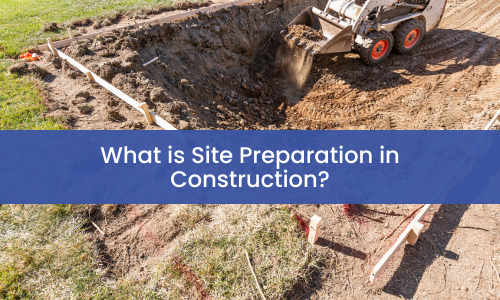Site preparation is an essential process that is scheduled before a construction project begins. The goal of site work is to get the area ready for construction and ready to bear structural weight.
A lot of planning, equipment and manpower are involved in every site preparation project Here is what the site preparation process entails:
- Site surveying and soil testing
- Land clearing and demolition
- Excavation (cutting and filling)
- Grading
- Soil stabilization (compaction)
- Drainage construction and erosion control
Site preparation can take a raw piece of land and convert it into something usable – whether it’s a residential subdivision, a commercial center or an industrial complex. As a vital aspect of any construction project, property owners should trust their dirt work to a proven site preparation crew.
A Step-by-Step Look at the Site Preparation Process
Depending on the size of the property and scope of the project, it may take months to see a site prep job through. Regardless of the size of the project, the site preparation process will look like this:
- Site surveying and soil testing – Before any machinery or manpower are mobilized, the site preparation team will survey the work site. During their survey, they will identify potential challenges to the project, as well as strategies that may improve work efficiency. For example, during the site survey, the site prep crew may determine where access roads should go or where onsite resources (soils, aggregates, reusable construction materials) can be harvested. The primary goal of the site survey is to confirm that the project is feasible as planned.
Part of this feasibility concerns the site’s soil. Soil composition greatly impacts its load-bearing capabilities and is therefore a critical consideration prior to any construction project. In the Houston area, “gumbo” soils that contain high concentrations of organic material are widespread. These soils will need to be stabilized before construction can move forward.
- Land clearing and demolition – Land clearing and demolition are the first steps in the process that involve actual dirt work. During land clearing, the site preparation team will use excavators and bulldozers to remove trees, shrubs and other vegetation out of the ground. Vegetation may be removed in a process known as “grubbing,” which removes trees and vegetation down to the root structures, ensuring they do not grow back. Rocks and other debris are also removed during the land clearing phase.
If existing structures are present on your future construction site, your site preparation team may be able to provide demolition services as well. During demolition, the demo crew will typically use heavy machinery like bulldozers, excavators, skid steers, track loaders, hauling trucks and possibly cranes for dismantling.
- Excavation (cutting and filling) – Once the construction site is clear, it’s time to start shaping the site. This starts with a rough grade that may involve extensive “cutting” and “filling” using extractors. Cutting and filling is the term given to removing soil (cutting) where it is not needed and moving it (filling) to where it is needed. Cutting and filling establishes the site’s overall shape, whether it is intended to facilitate drainage, improve the property’s appearance or for another purpose.
- Grading – Once the property’s overall shape has been established, it is time to establish those elevations to specification. Grading is done in several passes by dozers, skid steers and graders, which use an underslung blade that drags across the soil’s surface and precisely levels it out. Near the end of the grading process, the topsoil may be replaced to allow for new landscaping.
- Soil stabilization – Soil remains loose and unstable, which will require stabilizing following grading. All that cutting, filling and moving has left the site in a state where it cannot yet take construction. Site preparation teams stabilize soils through compaction, typically using rollers, or through chemical stabilization using additives like lime or cement, for instance. Stabilizing the soil strengthens it and imparts the needed load-bearing characteristics.
- Drainage construction and erosion control – Drainage is a primary concern for every Houston property owner, especially if the property has large areas of pavement, as asphalt and concrete are susceptible to water damage with extended exposure.
The site preparation team will use a variety of methods to minimize erosion and flooding. This includes grading the land to keep runoff from backing up on the property, as well as landscaping and putting in retaining walls to protect against erosion. Some site preparation teams are also able to install drainage structures like curb and gutter systems, catch basins and retention/detention ponds. These systems are essential for protecting Houston properties from water damage, no matter their size, layout or purpose.
Following site preparation, your site development partner may have the skills to excavate utility trenches and install foundations or pads for your buildings.
Site Preparation is a Foundational Part of the Construction Process
Long before any buildings go up, site preparation crews are hard at work in the dirt getting it ready for construction. This includes surveying, land clearing, excavation, grading, soil stabilization and drainage construction. Each step plays an essential role in construction, so partner with a reputable site preparation company with plenty of experience.
- Houston Parking Lot Lifecycles: Is It Time to Resurface, Overlay or Replace Your Pavement? - December 5, 2025
- Why Should Asphalt Maintenance in Houston be a Priority for Property Owners? - November 14, 2025
- What Factors Determine the Cost of Asphalt Services in Houston? - October 23, 2025

